Daily Do Now slides

This collection of “do now” resources is an ideal way to maximize news literacy learning in the opening minutes of class. These slides are designed to tap into research-based strategies to assist in effective classroom management, boost student engagement and improve retention. They can be used as formative assessment tools across subjects and grade levels.
How to use this collection:
- Bookmark this Google slides link, which will be updated every Friday at 5 p.m. ET with a new slide sequence for the coming week.
- Use these 5- to 10-minute bell ringer activities to reinforce news literacy concepts and spark discussion at the beginning of class.
- Refer to the “speaker notes” section at the bottom of the slides for educator links, instructions and details on standards alignment.
Each slide aligns with one of five primary standards from our Framework for Teaching News Literacy.
These standards invoke a combination of knowledge, skills and mindsets that are required to recognize credible information, avoid being exploited by misinformation and make informed, empowered choices.
-
Standard 1:
Students distinguish news from other types of information and can recognize both traditional and nontraditional advertisements.
-
Standard 2:
Students acknowledge the importance of the First Amendment in American democracy and a free press to an informed public.
-
Standard 3:
Students understand why professional and ethical standards are necessary to produce quality journalism, and they can apply understanding of those standards to discern credible information and sources for themselves.
-
Standard 4:
Students demonstrate increased critical habits of mind, including effective verification skills and the ability to detect misinformation and faulty evidence.
-
Standard 5:
Students express and exercise civic responsibility by seeking, sharing and producing credible information as effective participants in a democracy.
Note: You can also find this collection featured in The Sift, our weekly newsletter for educators. Some bell ringer slides spotlight topics included in that week’s newsletter.
We’d love your feedback! Please share your thoughts on these resources using this short form.
News Goggles: María Luisa Paúl, The Washington Post
News Goggles is back with fresh insights for the new school year. This regular newsletter feature offers a behind-the-scenes look at journalism and shines a light on key news literacy concepts. How do journalists see news? Put on a pair of “news goggles” to find out!
This week, we talk to Washington Post reporter María Luisa Paúl about her recent story on 7-year-old Tariq, whose love of corn made him a viral sensation. Paúl explains what makes a topic newsworthy in her role as a reporter for the Post’s Morning Mix team, which “covers stories from all over the nation and world.” She also highlights what a story like Tariq’s — who was dubbed “Corn Kid” by the internet — reveals about social media, internet culture and our world. Grab your news goggles!
Note: Look for this newsletter feature the first Monday of the month. You can explore previous News Goggles videos, annotations and activities in NLP’s Resource Library under “Classroom Activities.”
Resources:
- “Practicing Quality Journalism” (NLP’s Checkology® virtual classroom).
- “What is News?” (Checkology virtual classroom).
Dig deeper: Use this viewing guide for the featured News Goggles video as students consider what makes a topic newsworthy and how journalists organize their reporting.
News Goggles annotations and activities provide news literacy takeaways on timely topics. These resources feature examples of actual news coverage, including full news reports, headlines, breaking news alerts or excerpts.
This video originally appeared in the Oct. 3, 2022, issue of The Sift® newsletter for educators, which explores timely examples of misinformation, addresses journalism and press freedom topics and examines social media trends and issues. Read archives of the newsletter and subscribe here. Stock music in this video was provided by SoundKit from Pond5.
Have feedback about this resource? Or an idea for a future News Goggles? Please share it with us at [email protected].
News Lit Quiz: Should you share it? Education edition
News Goggles: Ad or news?
News Goggles annotations and activities offer news literacy takeaways on timely topics. These resources feature examples of actual news coverage, including full news reports, headlines, breaking news alerts or excerpts.
This News Goggles resource originally appeared in a previous issue of The Sift newsletter for educators, which explores timely examples of misinformation, addresses journalism and press freedom topics and examines social media trends and issues. Read archives of the newsletter and subscribe here.
When it comes to advertising, not everything online is as it first appears. Some ads, for example, are designed to look like news stories. To make things trickier, this kind of advertising has different names and is marked with different labels, including “sponsored content,” “native advertising,” “advertorial,” “paid post,” or hashtags such as #ad or #sponsored.
Let’s use our news goggles to tell the difference between ads and news — even when they look alike!
★ Featured News Goggles resource: These classroom-ready slides offer annotations, discussion questions and a teaching idea related to this topic.
Discuss: Have you ever mistaken an ad online or on social media for a news story? What made you think it was a news story? Do you think it is important for people to know the difference between news stories and advertisements? Which of these examples of advertising would you say is most responsibly and clearly labeled? Which is most confusing?
Idea: Ask students to keep a journal for a week on examples of different advertising, including branded content, that they come across as part of their typical news consumption. What labels do they notice? Were some ads hard to identify?
Resources: “InfoZones” and “Branded Content” (NLP’s Checkology virtual classroom); Informable® (NLP’s free mobile app).
Have feedback about this resource? Or an idea for a future News Goggles? Please share it with us at [email protected]. You can also use this guide for a full list of News Goggles from the 2020-21 school year for easy reference.
Critical observation challenge: Was Elsa really arrested?
This upper elementary slideshow activity introduces students to critical observation skills, or the ability to identify key elements in a piece of visual information text. By closely examining an actual social media post by a police department in Illinois about the “arrest” of Elsa from Disney’s Frozen, students identify evidence indicating that the photos and claims in the post are misleading. Students also consider and discuss the primary purpose of the post and what led to people’s confusion.
Essential questions
- How can social media posts be misunderstood?
- Why are critical observation skills important when using social media?
- What problems can arise when people take a joke on social media seriously?
- How can a joke fail on social media?
This news literacy classroom activity is suggested for grades 4-6.
Key terms
- Critical observation
- Evidence
- Purpose
How to speak up without starting a showdown
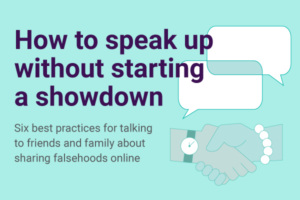 Misinformation is always problematic, but when it appears alongside pet photos and family updates on social media, it can be especially frustrating and unwelcome. It’s one thing if a stranger spreads falsehoods online. But what should we do when we see misinformation shared by family and friends?
Misinformation is always problematic, but when it appears alongside pet photos and family updates on social media, it can be especially frustrating and unwelcome. It’s one thing if a stranger spreads falsehoods online. But what should we do when we see misinformation shared by family and friends?
Stepping into the role of fact-checker when it comes to loved ones can be tricky and stir strong emotions, so it’s worth preparing for — especially as more falsehoods seep across social media and into family and friend group chats.
While every scenario is different, following some general best practices can help keep the conversation civil and make the interaction worthwhile. Use these six tips — with some helpful phrases for getting started — as a guide on how to speak up without starting a showdown. It may not be easy, but talking to loved ones about false or misleading content can help them think twice about what to share in the future.
“TRUST ME” discussion guide on manipulation and misinformation (collegiate guide)
 About the film
About the film
Misinformation is all around us, and it has real-world consequences. In today’s information landscape where anyone can publish almost anything, who — and what — can you trust?
“TRUST ME” is a feature-length documentary directed by Oscar-nominated Roko Belic that delves into the topics of manipulation and misinformation by exploring human nature, information technology, and the need for news and media literacy to help people trust one another. The film was produced by the Getting Better Foundation, whose mission is to build trust using the truth. For additional information about the film or its producers, or to get involved, go to the film’s website.
The film is available for purchase from New Day Films: “TRUST ME“.
About this guide
This guide was produced by the News Literacy Project (NLP) and Pamela Brunskill with support from the John S. and James L. Knight Foundation.
The guide is intended for adult learners in all settings, such as colleges, correctional facilities and community forums. Leaders should adapt, adopt and adjust these recommendations and ideas as they see fit.
The discussions we recommend are broken up into three sections: before viewing, during viewing and after viewing to help you establish, and build on, the core concepts in the film and reflect on the questions that result. Extension and further reading opportunities are listed at the end of the guide.
“TRUST ME” classroom guide: A unit on manipulation and misinformation
 About the film
About the film
Misinformation and disinformation are all around us, and have real-world consequences. In today’s information landscape where anyone can publish almost anything, who — and what — can you trust?
“TRUST ME” is a feature-length documentary that delves into the topics of manipulation and misinformation by exploring human nature, information technology, and the need for news and media literacy to help people trust one another. The film was produced by the Getting Better Foundation, whose mission is to build trust using the truth. For additional information about the film or its producers, or to get involved, visit TRUSTMEdocumentary.com and GettingBetterFoundation.org. The film is available for purchase from New Day Films.
The education cut of the film that accompanies this guide includes 15 segments. Depending on your schedule and objectives, you can show the full documentary or share it in segments.
About this guide
This guide was produced by the News Literacy Project (NLP) and Pamela Brunskill with support from the John S. and James L. Knight Foundation, which also funded the distribution of the education cut of the film.
The guide is intended for students in grades 4-6, 7-9, and 10-12+. The lessons are delineated for a particular grade band when appropriate and are designed for teachers to adapt, adopt, and adjust as they see fit.
The lessons are broken up into three sections: before viewing, during viewing and after viewing to allow for scaffolded development of concepts and understanding. Extension and further reading opportunities are listed throughout each of these sections.
“TRUST ME” discussion guide on manipulation and misinformation (for parents and caregivers)
 About the film
About the film
Misinformation is all around us, and it has real-world consequences. In today’s information landscape where anyone can publish almost anything, who — and what — can you trust?
“TRUST ME” is a feature-length documentary directed by Oscar-nominated Roko Belic that delves into the topics of manipulation and misinformation by exploring human nature, information technology, and the need for news and media literacy to help people trust one another. The film was produced by the Getting Better Foundation, whose mission is to build trust using the truth. For additional information about the film or its producers, or to get involved, go to the film’s website.
The film is available for purchase from New Day Films: “TRUST ME“.
About this guide
This guide was produced by the News Literacy Project (NLP) and Pamela Brunskill with support from the John S. and James L. Knight Foundation.
The guide is intended for parents and caregivers to aid in discussing the film with their families or other caregivers. They should adapt, adopt, and adjust these recommendations and ideas as they see fit.
The discussions we recommend are broken up into three sections: before viewing, during viewing and after viewing to help you establish, and build on, the core concepts in the film and reflect on the questions that result. Extension and further reading opportunities are listed at the end of the guide.
Fighting falsehoods on social media
The quiz embedded below measures how you know social media platforms’ policies designed to stem falsehoods from flooding your newsfeed. Different tech companies take different approaches, with some being more vigilant than others. In addition to implementing and enforcing their own policies, some platforms allow you to report misleading posts or provide information about the people and/or organizations that manage the page, including where they are located, when the page was created, whether the page has had other names, and whether it is running ads?
More important than ever
We have seen just how important such policies and tools are in 2020, with plenty of misinformation circulating about COVID-19, racial justice protests, wildfires and the presidential election.
For example, when you search “coronavirus” or “COVID-19” on certain platforms —you’ll learn which ones in the quiz — post from authoritative health sources or standards-based news organizations are prioritized at the top of the results. One social media platform has a “medical misinformation” option in its content reporting menu, and others are expected to follow suit.
Different approaches to political advertising
Falsehoods, rumors and manipulated content about elections, campaigns and politicians are nothing new, and some companies are working to keep such misleading content off their platforms. And one tech company banned political ads last fall, arguing that the reach of political messages should not be bought through internet advertising. But another online giant has taken a lenient approach to political advertising. Its policy has exempted politicians’ posts and ads from the company’s third-party fact-checking program because they are considered “newsworthy” even if they are untrue.
So take this quiz and see how much you know about the social media sites that you visit and the measures they are taking to protect the public. You might be surprised by how much you know or don’t know!
Sanitize before you share
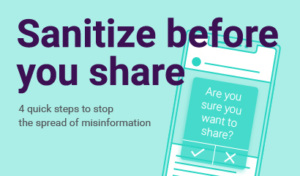 Misinformation swirling around the COVID-19 pandemic underscores the importance of consuming and sharing online content with care.
Misinformation swirling around the COVID-19 pandemic underscores the importance of consuming and sharing online content with care.
Public health officials are urging us to practice good hygiene to help stop the spread of this virus — by washing our hands thoroughly and frequently, staying home as much as possible, and keeping a safe distance from others when we do go out.
We can also practice good information hygiene.
Just adopt the four quick and easy steps below to help stop the spread of COVID-19 misinformation. If we sanitize the process around our information habits, we can prevent misleading and false content — some of which is hazardous to our health — from being widely shared and potentially doing harm.
How to know what to trust
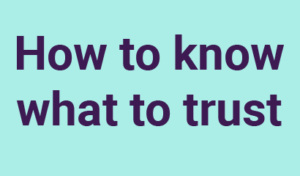 Misinformation comes at us every day, across many platforms and through a variety of methods. It’s all part of an increasingly complex and fraught information landscape. But what exactly do we mean when we say misinformation?
Misinformation comes at us every day, across many platforms and through a variety of methods. It’s all part of an increasingly complex and fraught information landscape. But what exactly do we mean when we say misinformation?
We define it as information that is misleading, erroneous or false. While misinformation is sometimes created and shared intentionally, it is often created unintentionally or as humor — satire, for example — that others later mistake as a serious claim.
Misinformation can include content that is wholly fabricated, taken out of context or manipulated in some way. Purveyors of misinformation often seek to exploit our beliefs and values, stoke our fears and generate anger and outrage. For example, during the 2016 U.S. presidential campaign, foreign governments, as well as organizations and individuals abroad and within the United States, flooded social media with disinformation. This nefarious form of misinformation is designed to sow discord, often around political issues and campaigns.
Don’t throw up your hands
While we might feel overwhelmed by the volume, frequency and increasing sophistication of misinformation in all its forms — from deepfakes and doctored images to outright propaganda — we can push back and regain a sense of control. News literacy skills that are easy to adopt can help us become smart news consumers.
To begin, we have identified seven simple steps that help you know what to trust. These steps can apply to information you encounter in the moment and over time. As these behaviors become ingrained in your information consumption habits, you will deepen your expertise.
You will then become savvy enough to flag misinformation when you see it, warn others about misleading content and help protect them from being exploited. In this way, you become part of the solution to the misinformation problem.
So start right here, right now by exploring the seven simple steps to learn “how to know what to trust.”
Get smart about COVID-19
Each of us needs to play a role in combating misinformation about the ongoing COVID-19 pandemic. When the outbreak hit the U.S. in spring, NLP created resources to provide the public, educators and students with accurate information about the illness.
We also created a quiz to test whether you can sort fact from fiction related to COVID-19 information. The World Health Organization called this deluge of information and misinformation about the pandemic an “infodemic’ for good reason.
Test your knowledge
The quiz embedded below will test your ability to accurately categorize information using a compilation of examples pulled from several sources. You will see news clips, social media posts, images, video, and charts and graphics. Then you must determine whether the content is opinion or news, is supported by valid evidence or whether the source cited is reliable.
If you have been paying attention to news about the pandemic these many months, you might find that some of the examples are easy. Yet others just might trip you up. Remember, this virus poses an ongoing and serious public health challenge. Since it appears COVID-19 will be with us for a while, it’s important to keep your skills sharp when it comes to determining what to trust, share or act on.
Your health and the health of your friends and family might just depend on it.
Should you share it?
When a news event or a significant issue grabs hold of the public’s attention, it’s human nature for us to want to get our hands on as much information as we can as fast as we can. It’s also human nature to act on an impulse to share that information with friends, family and the wider community in an effort to keep people safe from harm.
Unfortunately, large breaking news events — especially those connected to controversial, frightening and complex subjects, like the current COVID-19 pandemic — tend to generate a spike in viral rumors. These stories, anecdotes, ads and memes pass quickly from one person to the next, often with little regard to whether the content is true. Some elements may be accurate, but much is simply a form of digital rumor — half-truths, doctored videos and images, or complete fabrications.
Check your emotions and think critically
They typically appeal to our emotions, provoking anger, fear, curiosity or hope and overriding our rational minds and critical-thinking skills. When we have an immediate strong response to a piece of content online, our impulse is to take action: to “like” it, to share it immediately, to express whatever we’re feeling about it. Because of that impulse, and because Twitter, Facebook, Instagram, YouTube and other platforms effortlessly connect us to thousands of people (many of whom we’ve never even met), this content spreads rapidly across social media — even from one platform to another.
So think of these rumors like an actual virus. Mike Baker, a New York Times reporter in Seattle, has been tweeting weekly about the exponential increase in confirmed COVID-19 cases in the United States. A “like,” share or retweet of false or unverified content on social media spreads the same way — and the numbers are considerably larger.
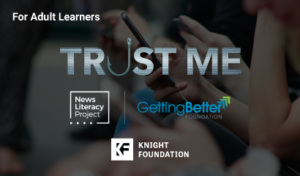 About the film
About the film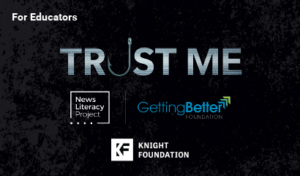 About the film
About the film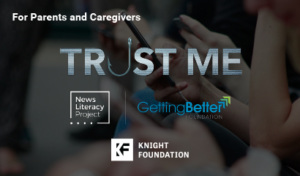 About the film
About the film